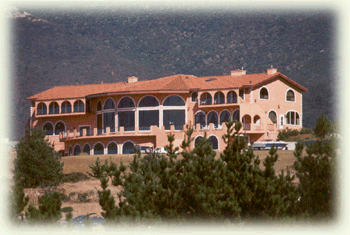|
 News News
 Subscribe to Our Newsletter Subscribe to Our Newsletter
 Sign up for Email Updates
Sign up for Email Updates
 CGF In the News
CGF In the News
 Press Inquiries Press Inquiries
 Past Articles Past Articles
 Calendar Calendar
|
|
|
Mega-homes threaten coastal and agricultural lands
by Lennie Roberts and Kathy Switky
As part of the Committee's work to monitor development proposals, Legislative Advocate Lennie Roberts keeps tabs on trends throughout San Mateo County. Over the past decade,
she's seen a marked trend toward larger homes proposed for rural areas: according to Planning Department records, the average size of homes built in rural areas of the County in 1993 was 2,500 square feet; by
2000, the average had quadrupled. These mega-homes now pose a significant threat to our open space and agricultural lands, particularly on the San Mateo County coast.

The Pelligrini mansion, at 21,000 square feet, is some ten times
larger than a typical coastal home such as that shown below.
Even one house that is out of scale - or out of character - with surrounding lands can have significant impacts. A monster home
can mar the landscape and view of an entire area, and can negatively impact infrastructure and coastal resources. And, perhaps most alarmingly, the Committee has seen increasing
numbers of individuals buy agricultural land in order to build trophy homes - a practice that significantly underminesthe viability of coastal agriculture in a number of ways.

Discretionary policies don't protect agricultural lands and open space
The San Mateo County Local Coastal Program (LCP) was devised to foster and encourage agriculture, and to preserve the maximum amount of agricultural land as an important coastal
resource. Development in the rural area is strictly limited so land prices are kept near agricultural, not speculative, values.
Once agricultural land becomes overpriced (which invariably
happens when mega-homes are built), these dynamics change. Pressure to abandon existing agricultural operations intensifies as land speculation increases, and tenant farmers who have never
owned their land will surely never have the opportunity to do so.
The rural areas of San Mateo County are the only zoning districts where house sizes are not limited by clear measurable standards.
Instead, there are numerous discretionary policies that are open to broad interpretation such as those requiring new homes to fit the area's character, be as unobtrusive as possible, and not detract
from the area's natural and visual qualities.
Because of these vague standards, the County's development review staff is under great pressure from applicants to
accommodate their desires. It is no surprise that some county planners have had difficulty applying these discretionary standards when faced with applicants who ask, "show me where it says I
can't build a house that is three, five, or even ten times larger" than the typical Coastside farmhouse. The results are staggering: a 21,000 square foot house now looms in a rural area next to
Montara, probably ten times larger than houses in the surrounding area. A number of other applicants have built similarly enormous houses; many others are building still-giant homes of "only" 8,000
square feet. County policies should be strong and clear
Committee for Green Foothills has been working with the Board of Supervisors to strengthen County policies so that new houses
must be compatible with the agricultural and open space character of the coast. The Planning Department, in response to direction from the Board of Supervisors, has proposed a maximum house
size of 5,000 square feet, with possible bonuses if certain criteria are met. This is a generous increase over a typical coastal farmhouse of 1,500 to 3,000 square feet. Since there are no size
limits on barns, sheds and other farm buildings, genuine agricultural operations would not be affected by these rules.
Importantly, these policies should be clearly understandable by
staff, applicants, the public, and the decision-makers. Strong policies will reduce, or even eliminate, the increasing number of appeals of such projects. Establishing maximum house size limits
will help everyone understand what is allowable, and thus will reduce conflict and delay.
The County Planning Commission and the Board of Supervisors need to continue to hear from us and know that there is strong
public support for regulations on rural home sizes. A finite limit to house sizes in rural areas of the County would significantly improve the policies already in place to protect the character and
open space of the rural Coastside.
The coast of San Mateo County is a truly special place. The coast should remain a place apart from the intensively developed areas
of the Peninsula, a place where agriculture can continue without becoming the new frontier for mega-homes.
Find out what you can do - read our action alert on this issue.
Published October 2002 in Green Footnotes.
Page last updated November 4, 2002
|
|
![]()
![]()




